FUGU (BLOWFISH) IN JAPAN
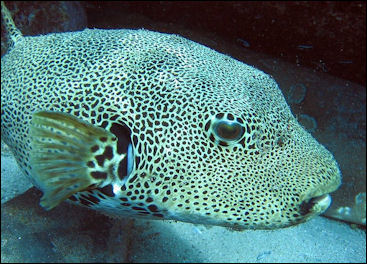
Eating “fugu”, Japanese puffer fish, has been called the gastronomic equivalent of playing Russian roulette. A powerful poison is found in the fugu's ovaries, kidneys, skin, eyes, liver and intestines. It is one of the most toxic substances known, hundreds of times more poisonous than strychnine or cyanide and so deadly that just of trace of it can kill an adult man in minutes. [Source: Noel Vietmeyer, National Geographic]
There are more than 120 species of puffer fish with differing poison capacity. Migaki fugu refers to fugu that has had its poisonous parts removed. The most dangerous part of the fish is the liver, which Japanese say is also near the tastiest meat. The methods for removing the poison from the liver are not always reliable. The best fugu chefs leave in just enough poison so it tingles the lips and gives one a tastes of the fragility of life.
Despite all this fugu is popular dish. Japanese eat 10,000 tons of fugu a year. There are 80,000 fugu chefs in Osaka alone. Fugu is considered a winter delicacy, typically eaten in December and January. Blowfish is also known as puffer fish and globefish. The fish of choice in Japan is “torafugu”, a species that is found in Japanese waters. The best fugu is said to some from Shimonoseki. Even though fugu is very poplar in Osaka, Tokyo is the nation's largest consumption center of the fish.The word “fugu” is made of two Chinese characters meaning “river” and “pig.”
Good Websites and Sources: Good Blog Report on Fugu japanfortheuninvited.com ; Wikipedia article on Fugu Wikipedia ; Fugu Preparation Video YouTube ; Eating Fugu haacked.com/archive ; Personal Account of Fugu Poisoning kyoshi.or.jp/inv-haiku/routine ; Endangered Blowfish american.edu/TED/blowfish ; New York Times article on Book on Blowfish and Zombies nytimes.com
Links in this Website: DIET AND EATING HABITS IN JAPAN Factsanddetails.com/Japan ;JAPANESE FOODS AND DISHES Factsanddetails.com/Japan ; FOOD SAFETY IN JAPAN Factsanddetails.com/Japan ; RICE AND NOODLES IN JAPAN Factsanddetails.com/Japan ; SOYBEANS, SOY SAUCE, NATTO, MISO AND TOFU IN JAPAN Factsanddetails.com/Japan ; JAPANESE VEGETABLES, FRUITS AND MUSHROOMS Factsanddetails.com/Japan ; JAPANESE BEEF, MEAT AND DAIRY PRODUCTS Factsanddetails.com/Japan ; SEAFOOD IN JAPAN Factsanddetails.com/Japan ; SUSHI Factsanddetails.com/Japan ; FUGU (BLOWFISH) IN JAPAN Factsanddetails.com/Japan ; RESTAURANTS AND FAST FOOD IN JAPAN Factsanddetails.com/Japan
Blowfish and Boxfish

fugu nabe
Blowfish have two very effective methods of defense: their bodies are covered by prickly spines and they can inflate themselves to three times their real size. Their relatives include the mola mola and the boxfish.
Blowfish gulp down water to inflate themselves like rigid balls and raise their spines to make themselves look threatening and unappetizing to predators. When bitten or swallowed by a predator they can still inflate themselves to two or three times their normal size and predators can not swallow or digest hem and have to spit them out.
Blowfish inflate themselves by pumping water into their stomachs (digestive functions are performed almost entirely by the small intestine).The blowfish stomach is pleated and can increase to 10 times its normal size. As the fish expands its spine bends into an upside-down position, with its internal organs squeezed between the backbone and the expanding stomach. The elastic skin stretches while a pleated inner skins hardens, giving the fish its rigidity. The pointed spikes which inwards when the fish is relaxed become erect and outward-pointing when the skin is stretched.
The boxfish is an unusual creature that has two sets of skeletons: one to support its body and another to support its internal organs. Resembling a pufferfish, it has a boxy shape produced by a rectangular (sometimes five sided) bony armor that covers two thirds soft their body. Its shape doesn’t look very hydrodynamic but actually is, and is especially well adapted for moving up and down and backward in the water column as well as forward. Automobile engineers at Mercedes Benz are studying the box shape to produce more aerodynamic vehicles.
Boxfish, pufferfish. ballonfish and cowfish (a close relative of the box fish whose frame extends forward to give it an appearance of having horns) propels themselves using their dorsal fin and anal fin and steer using their pectoral fins and tail. For many fish it is the other way around. Box fish can move quite quickly: six body lengths a second, stabilized by the keel-like edges of its carapace.
History of Fugu in Japan
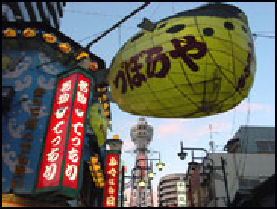
Osaka fugu restaurant Fugu bones have been found in burial mounds from the Jomon period (10,000 B.C. to 300 B.C.). Fugu was mentioned in Japan's first historical records, written in 720. In the late 1500s, fugu was banned by Toyotomi Hideyoshi after a mass poisoning of troops took place before an invasion of Korea. The ban remained in place for 200 years until, one story goes, Japan's first prime minister Hirobumu Ito ate some and survived and enjoyed it so much he demanded that the ban be lifted.
Shimonoseki on the southern tip of Honshu is particularly famous for fugu. About 500 fugu chef's live here. There is a bronze monument of a fugu in front of the fish market. There are even fugu pictured on the city's manhole covers. Every February people pray for a good puffer catch before a special shrine and fishermen send the Emperor a fugu as a gift. A local tourist brochure reads: "In the past, eating fugu was an adventure risking one's life."
The Japanese Emperor is forbidden from even touching fugu. In the Edo period (1603-1867) samurai were ordered to extinguish their family lines if they became poisoned.
The Haiku poet Tosa Buson wrote: “I cannot see her tonight I have to give her up So I will eat fugu”
Japan’s greatest poet Basho wrote: “Having eaten fugu soup Even though there also sea bream How irrational he was”
Blow Fish Poisoning
Tetrodotoxin is the poison in fugu. A neurotoxin that shuts down electrical signals in the nerves by disrupting the flow of sodium ions into nerve cells, it is about 500 to 1,000 times stronger than potassium cyanide. It is generally found in the intestines, liver and ovaries of the fish. One gram of fugu poison is enough to kill 500 people. There is no known antidote.
Another word for fugu in Japan is “teppo” ("pistol"). It comes from the expression “teppo ni ataru” ("to be shot"). The word “ataru” also means "to suffer from food poisoning."
Fugu poisoning first causes dizziness, numbness of the mouth and lips, weakness, nausea, diarrhea, sweating, breathing trouble, cramps, blue lips, intense itchiness, vomiting, and dilated pupils. Victims who eat a lot go into a zombie sleep in which victims are aware of what is going on but can't move.
Powerful toxins (lethal dose): 1) anthrax (0.0002); 2) cone shell (0.004); 3) textrodoxotine in the blue ring octopus and puffer fish (0.008); 4) inland taipan snake (0.025); 5) eastern brown snake (0.036); 6) Dubois’s sea snake (0.044); 7) coastal taipan snake (0.105); 8) beaked sea snake (0.113); 9) western tiger snake (0.194); 10) mainland tiger snake (0.214); 11) common death adder (0.500). Lethal doses is defined as the amount in milligrams needed to kill 50 percent of the animals tested.
Some fugu are poisonous and some aren’t, but even experts can’t explain why. Some scientists believe fugu is not naturally toxic. They have argued that fugu get the poison from ingesting tetrodotoxin-laden vibrio bacteria that is found in creatures that puffer fish such as starfish, worms and shellfish Others disagree, saying a fugu’s toxicity is produced by poison glands beneath the skin.
Scientists in Nagasaki have raised nonpoisonous fugu by feeding them a diet of mackerel and other nonpoisonous food. Fugu aficionados who have eaten these fish say they taste just as good as fugu with lethal organs. Some restaurant have a keen interest in offering the liver from the nonpoisonous fugu because this is the part of the fish, normally forbidden. Other sniff at the idea. One told AP, “Nontoxic fugu is boring. Fugu is exciting because it is toxic.”
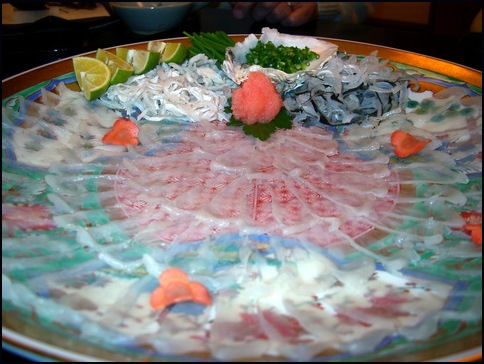
fugu sashimi
Death from Fugu Poisoning
Every year about 20 people in Japan suffer from fugu poisoning and few of these die. Fourteen people died of fugu poisoning between 2002 and 2006. In 2003, three people died. In 2000, two people died. In 1997, a bad year of fugu poisoning, six of the eight people who died from food poisoning nationwide died of fugu poisoning. In early 2009 six men in northern Japan were poisoned when they ate grilled blowfish testicles prepared by an unlicensed chef.
In the 1950s, 400 people were killed and 31,056 were sickened in one year alone. About 60 percent of people who eat tainted fugu die. Most of the fugu poisonings and deaths are attributed to amateur chefs who try to cut up the fish themselves without undergoing the special training needed to prepare it.
About 60 percent of the people who die from fugu poisoning suffer what the U.S. Food and Drug Administration called a "rapid and violent death." Within three to 30 minutes of eating fugu tainted with poison, victims begin showing symptoms. Many die from eating the liver which afficionados say is “ a great delicacy; once you eat, you can not stop.”
Fugu poisoning victims generally die with six to 24 hours after eating fugu, depending on the amount of poison ingested. Paralysis spread through the body while the victim is conscious. Death usually occurs from respiratory failure after the victims has gone into convulsions. One restaurant owner told National Geographic, "Even though you can think very clearly your arms and legs become numb. It becomes impossible to sit up. You can think but you cannot speak, cannot move and soon cannot breathe." In Japan, if someone died the family waits a few days before the burial incase the victim wakes up.
Many of the victims have been foolish. In January 1975, Mitsugoro Bando VIII, a Kabuki actor who was so famous he was designated a national treasure, died after having convinced a Kyoto restaurant to give him four servings of lethal fugu liver because he enjoyed the tingling sensation creating on his tongue and cheeks. First his arms and leg were paralyzed, then he had trouble breathing. He was dead in eight hours.
Between 1974 and 1984 over 200 people died of fugu poisoning in Japan, most from intentionally or non intentionally eating the liver from fish prepared at home. Captain James Cook almost died of fish after he tried a piece of liver in New Caledonia. In “From Russia with Love” one villain tried to kill James Bond with puffer fish poison.
A Canadian company is working on drugs that kill pain and offer addiction relief made from fugu poison. The drugs work by stopping the nerves from sending pain signals to the brain.
Zombies and Puffer Fish

In his books The Serpent and the Rainbow (1985) and Passage to Darkness: The Ethnobiology of the Haitian Zombie (1988), ethnobiologist Wade Davis argued that zombies were created by giving people tetrodotoxin poison taken from puffer fish that when given in the right doses makes a victim descend to near death and then awaken in a zombie-like state. The Serpent and the Rainbow was made into a film directed by the producer to The Nightmare on Elm Street series.
Victims of tetrodotoxin are paralyzed and have very light breathing just before they die. People who are poisoned but don’t die report being fully conscious while they are paralyzed but being unable to respond. In Japan there are stories of people who ate fugu and were presumed to be dead but woke up after a few days of having being in deep coma-like state of paralysis or woke up just as they were about to be cremated by relatives.
Although Davis never witnessed a zombie possession ceremony or even saw a zombie he spent two years among “boukors” (voodoo sorcerers) who almost always used puffer fish as an ingredient for "zombie powders" along with grated human bones and plants and herbs. To protect themselves while making the powders boukors placed cotton in their noses and covered themselves with burlap bags.
Many scholars criticized Davis's work because he never saw any zombies, some of his data was misrepresented and samples of his so-called "zombie powders" had hardly any toxins in them.
Fugu Murder in Sierra Leone
In January 2011, Tom Coghlan wrote in The Times, “A British businessman who died suddenly in Sierra Leone may have been poisoned using puffer-fish toxin, an inquest was told. David Hughes, 48, a former paratrooper, fell ill suddenly and died in June 2009 while trying to establish a business to turn palm oil into bio-diesel fuel. A post-mortem examination found traces of the poison tetrodotoxin, which is found in puffer fish. It was unclear how the poison entered his body and although the coroner said it was likely he died from puffer fish poison “in order to return a verdict that he was unlawfully killed — sure beyond a reasonable doubt — that someone did an unlawful act. There is no certainty.” [Source: Tom Coghlan, The Times, January 14 2011]
On the same story the Daily Mail reported: “Mr Hughes' business partner, Simon Boulton, who alerted British police because he suspected foul play, said: “Sometimes people out there use puffer fish to poison people.' Doctors examining Mr Hughes also considered an allergic reaction to a bee sting and severe food poisoning as the cause, but concluded tetrodox, for which there is no known antidote, was the most likely. [Source: Daily Mail, January 14, 2011]
Sierra Leonean police arrested Daniel Lansana, a local false vicar who worked with Mr Hughes, as a murder suspect. Three others were implicated in his death but no one has been charged Mr Lansana claimed his half-brother, Sheku 'Shuggy' Lansana, a Sierra Leonean former comrade of Mr Hughes, who helped set up the business, poisoned him. Mr Lansana was concerned Shuggy was spending money they had given him to buy equipment and machinery on drink instead. They agreed Mr Hughes would travel to Sierra Leone to sort the problem out, and encourage Shuggy to return to the UK to 'sort himself out'.
The statement said after agreeing this, Shuggy, Daniel Lansana and Mr Hughes had a farewell dinner at a hotel on June 3, 2009. The next day Mr Hughes told family via text message that a strange spot had appeared on his head. His eyes began to swell and he got a headache two days after the meal with Shuggy. He was later rushed to hospital in a critical condition after suffering stomach cramps and vomiting. He died in hospital two days later.
Preparing Fugu
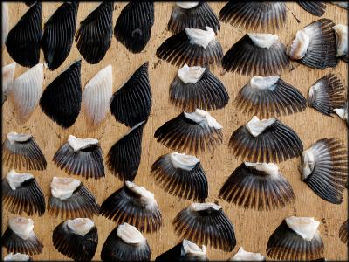
fugu fins To prepare fugu a cook must follow 30 prescribed steps. After the poisonous parts have been removed with a “hocho” knife the fish is cut into pieces and then washed under water to remove the toxins and blood. The poisoned organs are placed in special bags that must be kept under lock and key and disposed of like radioactive waste in a special incinerator.
Chefs who prepare fresh fugu take a live fish from a tank and knock it unconscious with a blow to the head with a mallet. The flesh is cut into thin slices and the heart is removed while it is still beating. Applying pressure to certain area around its gills cause the fish to puff up.
Some chefs say that removing the portions that contain the toxins is a relatively simple process. Others disagree. The poisonous parts can vary between different species of blowfish. One marine biologist told the Daily Yomirui. “Even professionals have trouble determining the poisonous part of some blowfish because they differ by type. The same fish needs to checked by more than one person with proper knowledge.”
The famed sushi chef Yitaka Sasaki told the Los Angeles Times that the notion of fugu making a diner’s lip number is a fallacy. “That’s a lie,” he said. “If you’re eating fugu and your lips turn numb. You’re well on way to being dead..”
Licensing of Fugu Chefs
It takes about 11 years to become a full-fledged fugu chef. All cooks in Tokyo that prepare fugu are licensed. They have go through a three year apprenticeship under a master, take intensive courses, pass a written exam and show skill making about a dozen types of fugu dishes.
An apprentice studying to get his fugu license told National Geographic, "There's a written exam that lasts two hours. They next day they hand you fugu, knife and twin pans.” In 20 minutes test-takers must put all the poisonous parts in one pan and all the edible parts in the other, label the parts with plastic tags (red for toxic, black for edible) and prepare a meal in an artful arrangement. The hardest part of the test is separating out the female ovaries, one of the deadliest parts, which look almost identical to the male’s testicles, which are a delicacy. If you mix them you fail the test. Around 800 to 900 people take the test every year, with about two thirds of those taking it passing.
Th chefs in Tokyo may have to serve a three-year apprenticeship and have to pass a stringent test under the watchful eyes of health officials but this is not the case everywhere. There is no centralized regulation and it is difficult to say for sure who is licenced and who isn’t, Only 19 of Japan’s 47 prefectures requires chefs to pass an exam to obtain a fugu license.
Fugu Preparation Regulations
Each prefecture has its own ordinance on the handling of fugu. In Tokyo, only general licensed chefs who have undergone at least two years of training at fugu restaurants are entitled to take a certification test in order to prepare migaki fugu. They must pass extremely difficult practical and written exams. However, in some regions such as Kyushu, there are no restrictions on migaki fugu sales, enabling Tokyo residents to bypass metropolitan government restrictions by ordering the fish via the Internet. The Tokyo metropolitan government said there are no restrictions on selling migaki fugu in 29 prefectures.[Source: Yomiuri Shimbun, March 17, 2012]
The Tokyo metropolitan government enacted the ordinance on fugu in 1949, the nation's first licensing system for preparation of the fish, in response to numerous deaths from fugu poisoning during a period of food shortages after World War II, "Fugu restaurants urged the Tokyo government to create the licensing system," Yuichi Makita, the chairman of an association of fugu restaurants told the Yomiuri Shimbun. "The system helped fugu to become recognized as a safe fish to eat."
Under Tokyo's regulations, businesses with licensed fugu chefs are the only ones permitted to buy, process and sell fugu fresh from the ocean and migaki fugu. Tokyo considered allowing the sale of migaki fugu in the 1980s but decided against this move after discovering that in some cases the fish's poisonous parts had not been sufficiently removed.
Tokyo eases Fugu Preparation Regulations
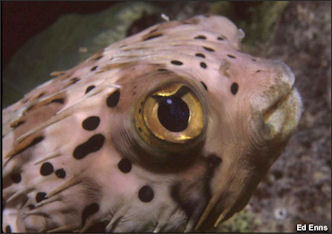
balloonfish
In 2013, strict government ordinance on the fugu trade in Tokyo were eased. Under the new rules set by the Tokyo metropolitan government shops and restaurants that do not have certified fugu chefs will be able to sell "migaki fugu," or fugu that has had its poisonous body parts removed, and "processed fugu," which describes the fish when it has been cut into pieces after the removal of its dangerous body parts. This type of fugu is primarily served in dishes such as sashimi and hot pots. [Source: Yomiuri Shimbun, March 17, 2012]
The Yomiuri Shimbun reported: “The metropolitan government has decided the safety of migaki-fugu products can be ensured because the high level of expertise among workers handling fugu makes it unlikely that the fish will be distributed before its poisonous parts are completely removed.
Under the new ordinance, shops and restaurants without certified fugu chefs must display a sign showing they only serve migaki fugu, and will be required to report to the metropolitan government. They will also need to purchase certified migaki fugu, labeled to indicate the poisonous parts have been removed, and keep records on where they bought the fish.
Daichi Sakamoto, president of the Torafugu-tei fugu restaurant chain, said, "The strict regulations have protected Tokyo's fugu industry, and this has kept the fish's prices high." The chain has created about 50 restaurants in the Kanto region since expanding from Osaka to Tokyo about 15 years ago.Sakamoto said he welcomes deregulation, "It will help us as well." easing restrictions will give Tokyo residents more opportunity to eat fugu, causing the market to expand.
But Naoto Yako, head of Ginza Naruto, a fine-dining restaurant selling fugu in Ginza, has concerns about safety. Yako is worried that some dealers and restaurants that do not have certified chefs may buy fugu that has not had the poisonous parts removed, in order to illegally process and sell the products. Some fugu restaurants in Tokyo are considering whether to display signs indicating that they have licensed fugu chefs, Yako said.
Puffer Fish Dishes
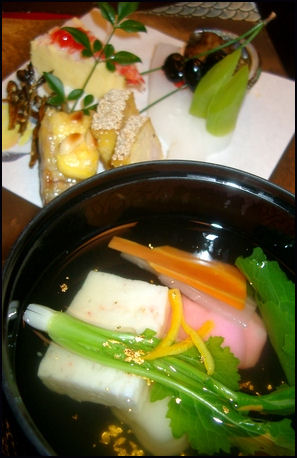
fugu nabe Generally a fugu meal goes for between $40 and $100 per person and typically has five courses with raw fugu being first followed by fried fugu and stews, soups and broths made with parts such as skin and testes. Boiled fugu is often marinated in vinegar and topped with daikon radish-hot pepper sauce and dipped in a mixture of Welsh green onion, seaweed and soy sauce.
In Shimonoseki, thin slices of raw fugu are wrapping around thin slices of fish around slivers of green onions and dipped in a sauce made of soy sauce, radish and red pepper. This is followed fugu stew (nabe), featuring chunks of fugu meat cooked at the table in an earthen pot along with cabbage, spinach, tofu and shiitake mushrooms. Items are extracted from the pot with chopsticks and dipped in soy sauce and citrus juice, sometimes flavored with chili paste and grated daikon. The tail is used as a decoration and the remaining stew broth is mixed with rice. All this is for about $80 per person.
The thinly sliced raw flesh of the tiger fugu is said to be the best. A plate of the paper thin slices for four people, arranged into patterns of flowers or birds, goes for over $200.
Fugu testicles eaten before the mating season, when they are full and mature, are regarded as a special delicacy. Hot sake prepared with fugu fins has a reputation for producing a mellow buzz. Many restaurants serve the slices in the shape of chrysanthemum, a traditional funeral flower.
Eating Fugu
Fugu is very popular in Japan. Tokyo has around 800 certified fugu restaurants. There are about 3,800 nationwide. The certification that shows that chefs have passed the fugu preparation test generally is prominently displayed. A chef at a fugu restaurant told the Yomiuri Shimbun, "We age a mature fugu for two days and then slice it into sashimi. This process maximizes the level of inosinic acid, which helps give fugu its delicious taste.”
Fugu is traditionally eaten in the winter and associated with the city of Shimonoseki. January and February are the best times to eat fugu because cold water makes the meat more elastic. Wild fish caught when there is a cold wind are said to be especially tasty.
Fugu is a dense, white fish with a very delicate and arguably ordinary taste. Japanese like the texture and elasticity of the meat. Many Westerners complain that fugu is overrated. With all the fuss and danger associated with it, the bottom line is that fugu doesn’t taste all that great. Noel Vietmeyer wrote in National Geographic, "The meat had no fiber and was almost like gelatin. It is very light in taste. More like chicken than fish, with a slight hint that it is a seafood." Often the various sauces and seasoning have more taste than the fugu.
Fugu aficionados like a little poison, enough to tingle the lips and numb the tongue. The ultimate dish is “chiri”, fugu cooked in a broth made from the poisonous livers and intestines. Some even eat the poisonous organs (after the poison has been soaked out). “Hirezake” (cooked fugu tail in hot sake) is traditionally sipped with a fugu dinner. Sometimes it set on fire first to burn off some of the alcohol. Women like dishes with the skin because it contains large amounts of collagen, which is said to be good for human skin.
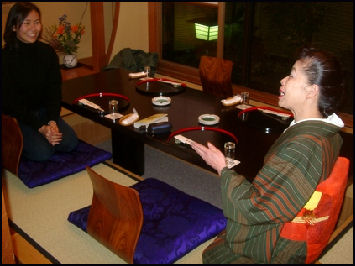
fugu restaurant Describing a fugu meal at a Shimonoseki restaurant, Yasushi Wada wrote in the Yomiuri Shimbun: “Fugu is available throughout the year, but it is most delicious in the winter before it spawns... I watched a chef finely slicing fugu and arranging it on an elaborately decorated plate. The cook, an artist really, has been preparing fugu for 28 years. With great skill, the chef sliced the translucent fish into pieces just two millimeters thick and arranged them in a chrysanthemum pattern...I popped a slice of fugu into my mouth without dipping it in ponzu (a sauce made of soy sauce and citrus juice). My mouth quickly filled with the fish's wonderful flavor. If the fish was not so expensive, it would grace my dinner table more often.”
When eating fugu is considered bad manners to make jokes about the dangers associated with the fish such as insisting that other people eat the first bite or faking convulsions. Worst of all is acting horrified over the cost when the bill arrives.
Restaurants in Osaka serve twice as much fugu as restaurants in Tokyo. In Tokyo people pay extra money get top name Shimonoseki brand. People from Osaka don’t care. They want to eat something that is supposed to be expensive but get at a cheap price. Tokyoites prefer their fugu prepared as shashimi arranged is elegant displays. People from Osaka like theirs cooked with vegetables in a pot of nabe.
Raising Farmed Blow Fish
In Japan, 22 different kinds of fugu have been approved by the government for use in restaurants. But the poison is found in different organs in different fish and sometimes is found in the tissue and skin. That is one reason why the licensing process is so rigorous.
Most fugu are farm raised and these are less dangerous than fugu found in the open sea. Farmed fugu are raised in large circular tanks and have their mouths sewn shut so they don’t attack one another. Today some fish farmers are raising filefish, a fish with a taste similar to fugu.
About 4,500 tons of farmed fugu is produced in Japan annually. It sells for about one fifth the price of wild fugu. You can tell the difference between farmed and wild fugu by tasting the white meat. Farmed fish taste like sardines and mackerel, the fish they are fed, while wild fish tastes like shrimp and crab the food they feed they on.
Noguchi of Nagasaki University is raising non-poisonous fugu with the aim of selling the liver, the sale of which has been banned since 1983. In some ways he laments his potential success, telling National Geographic, “a fugu without its poison is like a samurai without his sword.”
In 2009, Optima Foods, a company in Ehime Prefecture, announced that it successfully bred takifugu to be poison-free on an aqua farm in the middle of the mountains in a pond made of underground mineral water mixed with salt and minerals. Restauranteurs said the fish were bigger than those caught in the sea and the meat tasted much better than other farmed fugus.
The blowfish trade is strictly regulated by local governments. Those who break the ordinances on the sale of blowfish in Tokyo can be imprisoned for up to two years and fined ¥500,000. In 2002, an unlicenced company in Hokkaido shipped a large amount of blowfish containing poisonous parts.
There are 20 firms in Shimonoseki hat specialize n removing the harmful organs. Today at supermarkets and at fishmongers you can buy fugu that has been gutted and boned and ready to eat as sashimi or thrown in a pot of nabe.
Catching Wild Puffer Fish
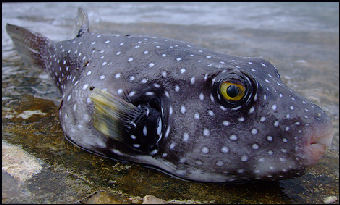
a beached fugu Connoisseurs prefer wild varieties, which are generally much more expensive. The best ones are said to caught in the Yellow Sea or off Hagi, Yamagata Prefecture, in the Sea of Japan followed by those caught off Tokuyama (Chunan) in Yamaguchi Prefecture and those taken in the Bungo Channel and the Sea of Genkai. These day many wild blowfish are caught in the Sea on Enshu. This was no the case a few years ago and may to be the result of a change in ocean currents
Mitsuho Yoshida wrote in the Yomiuri Shimbun, “Their birth and breeding matter. Their looks also are important. They are not supposed to have buck teeth, a spoon-like chin or even a beetle brow.
The main fugu fishing season is from October to February. Many of the vessels that seek fugu n the Sea of Enshu leave from Maisaka Port in Shizuoka Prefecture. Each morning at 4:30am a lottery is held to the location of where each of the 60 ships will fish in the ocean with the vessels leaving port before dawn to catch blowfish with long lines and returning to port in the afternoon with about half the catch loaded onto to trucks and transported live to Shimonoseki.
Fugu Auction
Haedomari Market in Shimonoseki is the sole market specializing in the fugu trade. The auction there starts after 3:00am. Quality fish known as “beppin” or beauties, are sold mostly to high-end restaurant in Tokyo and Osaka. About 300 tons are wild blowfish are put on auction every year at the market, with an average of about 1 ton a day. Blowfish sold at the market are distributed as “fugu from Shimonoseki,” regarded as a top blowfish brand both in terms of taste and safety.
Describing the scene at the fugu action at the fish market in Shimonoseki, Yasushi Wada wrote in the Yomiuri Shimbun: “At 3:20 a.m., a group of men gathered at the Haedomari market to communicate secretly using hand signals. But this was no meeting of spies or a secret society, it was a serious business: bidding for fugu, renowned for their exquisite flesh. The "fukuro-zeri" (bidding in a bag) auction is a unique feature of the market in Shimonoseki, the distribution point for 40 percent of the nation's fugu.” [Source: Yasushi Wada, Yomiuri Shimbun]
“To make a deal, a man controlling the bidding puts his right hand into a black cloth sleeve and buyers put their hands one after another in the other end of the sleeve. The buyers convey how much they will pay for the fugu by grasping the other man's fingers in a certain way. After all the buyers have given their "secret code," the "auctioneer" then points to the successful bidder.”
“When fugu is mentioned, Shimonoseki immediately comes to mind because of the large number of people in the city who can perform migaki, according to Hajime Sakai, president of Sakai Shoten, an intermediate wholesaler. Sakai's company has been dealing in fugu for about 80 years. "My company not only sends fugu to Tokyo's Tsukiji market, but supplies shops around the country," he said.
Image Sources: 1) JNTO 2) Japan Visitor 3) 6) 7) Phil Haack's Haacked blog; 4) Shimonoseki site 5) Ray Kinnane 8) Hector Garcia
Text Sources: New York Times, Washington Post, Los Angeles Times, Daily Yomiuri, Times of London, Japan National Tourist Organization (JNTO), National Geographic, The New Yorker, Time, Newsweek, Reuters, AP, Lonely Planet Guides, Compton’s Encyclopedia and various books and other publications.
Last updated August 2020
